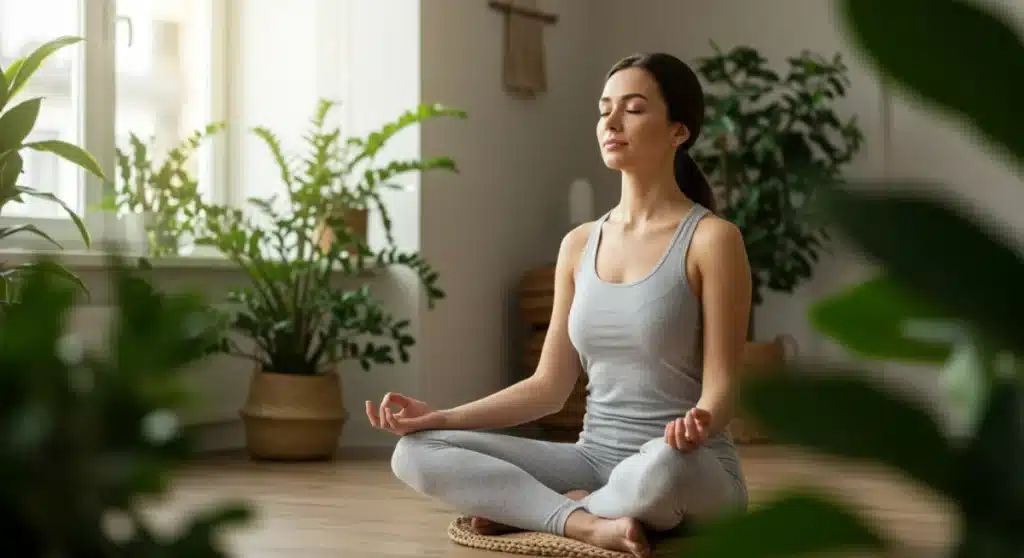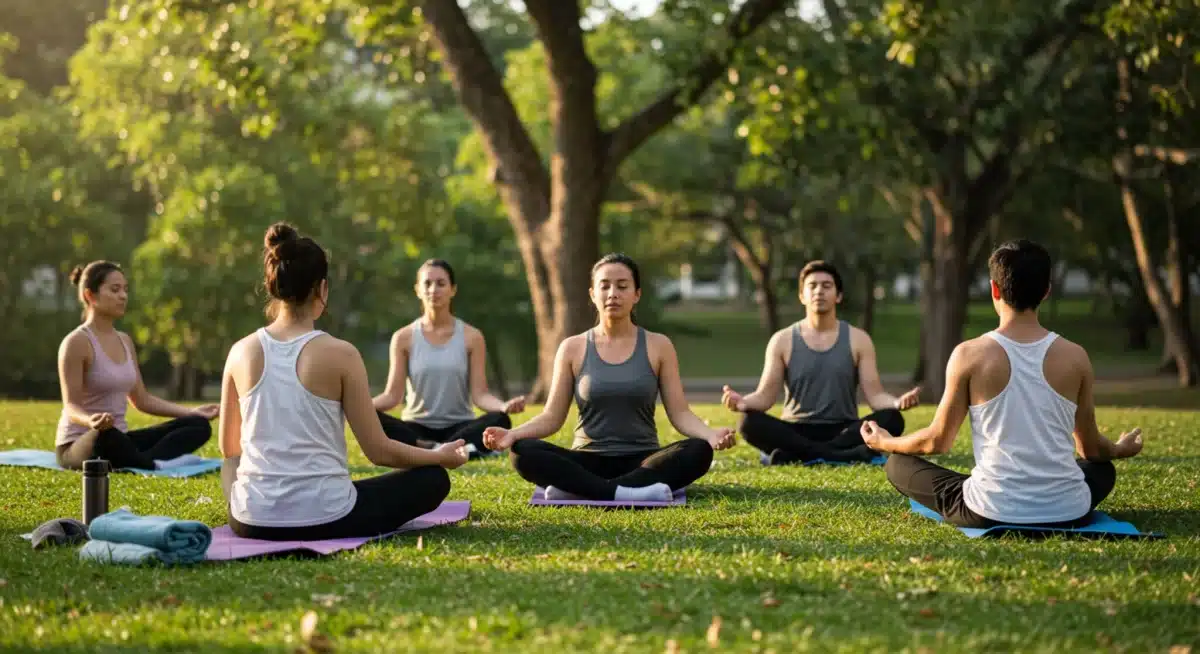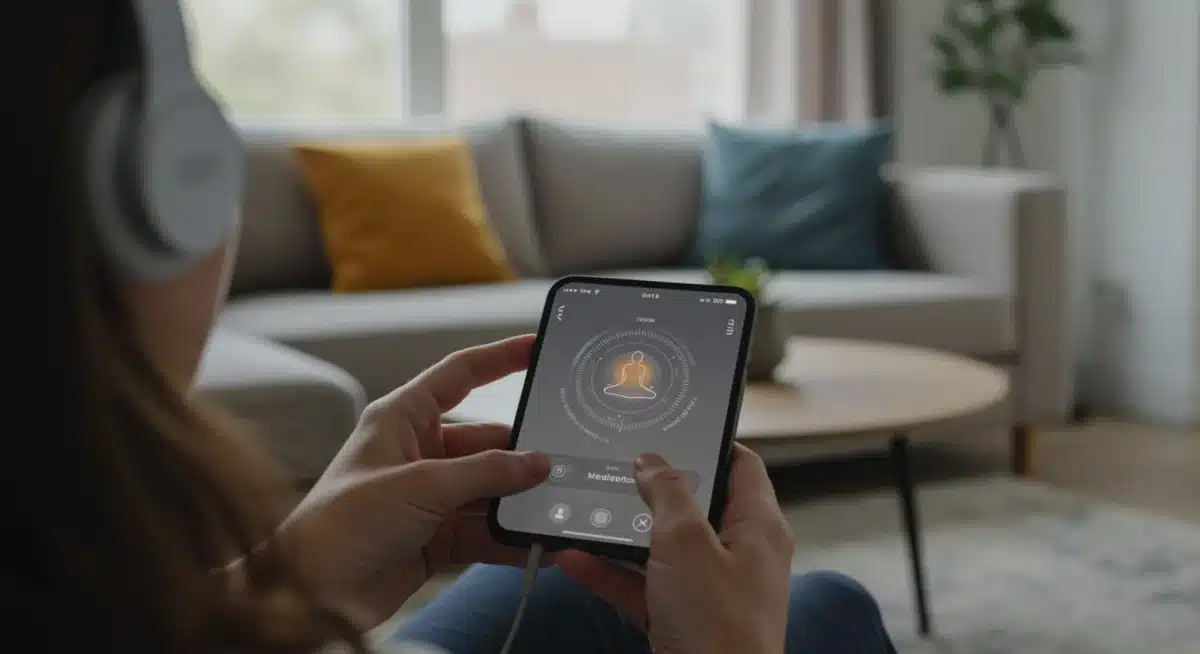Unwind & Relax: Latest Meditation for Stress Relief

The latest meditation techniques offer effective pathways to unwind, relax, and find profound stress relief amidst modern life’s demands, fostering greater mental clarity and emotional balance for enhanced well-being.
In our fast-paced world, finding moments of calm can seem like a luxury rather than a necessity. Yet, the persistent hum of daily stressors often leaves us feeling overwhelmed and disconnected. This is precisely why exploring the latest meditation techniques for stress relief has become more vital than ever, offering accessible and powerful tools to reclaim our inner peace and mental clarity.
The Evolving Landscape of Meditation for Modern Life
Meditation is no longer confined to ancient monasteries or esoteric practices; it has seamlessly integrated into mainstream wellness, adapting to the demands of contemporary living. The evolution of meditation techniques reflects a growing understanding of the human mind and its capacity for resilience when nurtured effectively.
Modern life presents unique challenges to our mental well-being. Constant digital connectivity, demanding work schedules, and a relentless news cycle contribute to elevated stress levels. Traditional meditation forms, while powerful, sometimes require a sustained discipline that can be daunting for beginners. This has spurred the development of innovative, accessible, and often shorter practices designed to fit into busy schedules.
Bridging Ancient Wisdom with Contemporary Needs
The core principles of meditation remain timeless: cultivating awareness, focusing attention, and fostering a sense of inner calm. However, the methods through which these principles are taught and practiced have undergone significant transformation. Today, meditation is often presented in digestible formats, making it less intimidating and more approachable for a wider audience seeking genuine stress relief and mental clarity.
- Accessibility: Meditation apps and online platforms have democratized access, allowing anyone with a smartphone or internet connection to learn and practice.
- Integration: Techniques are now frequently integrated into corporate wellness programs, educational curricula, and even healthcare settings, acknowledging their broader benefits.
- Personalization: A greater emphasis is placed on finding a meditation style that resonates with individual needs and preferences, moving away from a one-size-fits-all approach.
The goal is to demystify meditation, presenting it not as a complex spiritual endeavor but as a practical mental exercise that can significantly improve quality of life. By understanding the diverse array of options available, individuals can embark on a personalized journey toward greater calm and resilience.
This evolving landscape ensures that meditation remains relevant and effective in addressing the pervasive issue of stress in modern society. It empowers individuals to take proactive steps towards their mental health, offering a sanctuary of peace within the chaos of everyday life.
Mindfulness-Based Stress Reduction (MBSR) and Its Enduring Impact
Mindfulness-Based Stress Reduction (MBSR) stands as a cornerstone in the modern meditation movement, having been developed by Jon Kabat-Zinn in the late 1970s. Its enduring impact stems from its scientific rigor and its proven efficacy in reducing stress, anxiety, and chronic pain. MBSR is a structured eight-week program that combines mindfulness meditation, body scan, and gentle yoga, teaching participants to be more present and aware of their thoughts, feelings, and bodily sensations without judgment.
The program’s success lies in its secular approach, making it accessible to individuals from all backgrounds. It emphasizes direct experience and self-observation, guiding participants to cultivate a non-reactive awareness of the present moment. This practice helps to break the cycle of automatic negative reactions to stress, fostering a sense of calm and control.
Key Components of MBSR Practice
MBSR is built upon several foundational practices that, when combined, create a comprehensive approach to mindfulness. These components are designed to gradually train the mind to observe rather than react, ultimately leading to a more peaceful state.
- Body Scan Meditation: This practice involves systematically bringing attention to different parts of the body, noticing sensations without judgment. It enhances body awareness and helps release tension.
- Sitting Meditation: Participants focus on the breath, sounds, or bodily sensations, gently redirecting attention whenever the mind wanders. This builds concentration and non-judgmental awareness.
- Mindful Movement (Gentle Yoga): Simple yoga postures are performed with full attention to the body’s movements and sensations, integrating mindfulness into physical activity.
- Informal Practices: Extending mindfulness to everyday activities like eating, walking, and communicating, fostering a continuous state of presence.
The beauty of MBSR is its emphasis on integrating mindfulness into daily life, not just during formal meditation sessions. This holistic approach ensures that the benefits of the practice extend beyond the cushion, influencing how individuals navigate their daily experiences.
Through consistent practice, MBSR helps individuals develop a greater capacity to respond skillfully to stress rather than being overwhelmed by it. It offers a pathway to profound self-awareness and emotional regulation, making it an invaluable tool for anyone seeking to mitigate the effects of modern stress.

Breathwork Techniques: Harnessing the Power of Your Breath
Breathwork, an ancient practice gaining renewed popularity, focuses on conscious and controlled breathing techniques to influence physical, mental, and emotional states. It’s a powerful and immediate tool for stress relief because the breath is directly linked to the autonomic nervous system, which controls our fight-or-flight response. By intentionally altering our breathing patterns, we can consciously shift our nervous system from a state of stress to one of relaxation.
Unlike some meditation forms that require extensive training, many breathwork techniques can be learned and applied quickly, offering immediate relief. This makes them particularly appealing for those seeking rapid de-escalation of stress or anxiety in high-pressure situations. The simplicity and effectiveness of breathwork contribute to its growing recognition as a vital component of a holistic wellness routine.
Popular Breathwork Methods for Calm and Focus
Various breathwork techniques exist, each with its unique rhythm and focus, yet all share the common goal of promoting relaxation and mental clarity. Understanding a few key methods can help individuals choose the practice that best suits their needs.
- Diaphragmatic Breathing (Belly Breathing): This technique emphasizes breathing deeply into the diaphragm, rather than shallow chest breathing. It stimulates the vagus nerve, which helps slow the heart rate and promote relaxation.
- Box Breathing (4-4-4-4): Inhale for a count of four, hold for four, exhale for four, and hold for four, repeating the cycle. This method is excellent for calming the nervous system and improving focus, often used by military and first responders.
- 4-7-8 Breathing: Inhale through the nose for four counts, hold the breath for seven counts, and exhale completely through the mouth for eight counts. Developed by Dr. Andrew Weil, this technique is praised for its ability to induce sleep and reduce anxiety.
Regular practice of breathwork can lead to a more balanced nervous system, reduced muscle tension, improved sleep quality, and a greater sense of emotional resilience. It’s a foundational practice that complements other meditation techniques, providing a direct pathway to inner calm.
By consciously engaging with our breath, we unlock an innate mechanism for self-regulation and stress reduction. Breathwork offers a tangible and accessible method for anyone looking to quickly shift their internal state towards greater peace and well-being.
Sound Bath and Vibrational Healing: A Sensory Path to Relaxation
Sound baths and vibrational healing represent a unique and deeply immersive approach to relaxation and stress relief. These practices involve being enveloped in resonant sounds produced by instruments like Himalayan singing bowls, gongs, crystal bowls, and chimes. The theory behind these techniques is that the vibrations and frequencies generated by the instruments can harmonize with the body’s own energetic frequencies, promoting deep relaxation and a meditative state.
Participants typically lie down comfortably, allowing the sounds to wash over them. The experience is often described as a journey, where the mind is gently guided away from daily worries by the rich tapestry of sounds. This passive form of meditation can be particularly beneficial for those who find traditional silent meditation challenging, as the sounds provide a focal point that naturally draws attention away from intrusive thoughts.
The Science and Experience of Vibrational Healing
While the full scientific understanding of sound baths is still evolving, preliminary research and anecdotal evidence suggest a range of benefits, from reducing anxiety and depression to improving sleep and overall well-being. The rhythmic and harmonious sounds are thought to influence brainwave states, shifting them from beta (alert, waking state) to alpha (relaxed, creative state) and even theta (deep relaxation, meditative state).
- Resonance and Entrainment: The body’s cells and energy fields are believed to resonate with the healing frequencies, leading to a state of balance and calm through a process called entrainment.
- Deep Relaxation: The immersive soundscapes facilitate a profound state of relaxation, often leading to a sense of weightlessness or floating, and reducing mental chatter.
- Emotional Release: For some, sound baths can facilitate emotional release, allowing deeply held stress or trauma to surface and be processed in a safe and supportive environment.
The experience of a sound bath is highly personal, but many report emerging feeling refreshed, centered, and profoundly peaceful. It’s a powerful reminder of how our sensory experiences can be harnessed to promote healing and relaxation.
As a complementary therapy, sound baths offer a non-invasive and deeply soothing method for engaging with meditation. They provide a unique avenue for individuals to unwind and explore deeper states of consciousness, fostering significant stress relief and mental rejuvenation.
Digital Meditation Tools and Apps: Your Pocket-Sized Guru
The digital age has revolutionized access to meditation, transforming it from an often-exclusive practice into a readily available resource. Meditation apps and online platforms have emerged as powerful tools, acting as pocket-sized gurus that guide millions through various techniques. These digital aids offer convenience, personalization, and a structured approach to learning and sustaining a meditation practice, making it easier than ever to incorporate mindfulness into daily life.
From beginners seeking introductory courses to experienced practitioners looking for specific guided meditations, these platforms cater to a wide spectrum of needs. They often feature diverse voices, thematic sessions, and customizable settings, allowing users to tailor their meditation experience to their preferences and current emotional state. This accessibility is crucial in a world where time constraints and lack of local resources can be significant barriers to mental wellness practices.
Features and Benefits of Modern Meditation Apps
The best meditation apps are designed with user experience in mind, offering a rich array of features that enhance the practice and encourage consistency. They leverage technology to create an engaging and supportive environment for mental well-being.
- Guided Meditations: A vast library of guided sessions covering topics like stress, sleep, focus, and anxiety, led by experienced instructors.
- Customizable Programs: Tailored meditation plans based on user goals, experience levels, and available time, providing a structured learning path.
- Mindfulness Timers and Soundscapes: Simple timers for unguided practice, often accompanied by soothing background sounds like nature ambiences or binaural beats.
- Progress Tracking: Features to monitor meditation streaks, total time meditated, and mood tracking, which can motivate consistent practice.
The integration of these tools into our daily routines means that a moment of calm is always just a tap away. Whether it’s a five-minute breathwork session between meetings or a longer guided meditation before bed, digital platforms make consistent practice achievable.
By leveraging technology, these apps democratize access to powerful meditation techniques, offering a convenient and effective way to manage stress and cultivate inner peace. They empower individuals to take charge of their mental health, transforming their smartphones into tools for tranquility rather than sources of distraction.

Movement-Based Meditations: Finding Stillness in Motion
Movement-based meditations offer a dynamic alternative to seated practices, appealing to those who find it challenging to sit still or prefer a more active approach to mindfulness. These techniques integrate physical activity with present-moment awareness, turning ordinary movements into opportunities for meditation. The core idea is to bring conscious attention to bodily sensations, breath, and the environment while engaged in gentle, repetitive, or flowing movements, thereby calming the mind and reducing stress.
This approach recognizes that the body and mind are intricately connected, and engaging one can profoundly influence the other. For many, physical movement helps to release pent-up energy and mental chatter, making it easier to enter a meditative state. It’s a powerful way to cultivate mindfulness without the pressure of maintaining a static posture, fostering a sense of freedom and fluidity in practice.
Exploring Active Mindfulness Practices
Several movement-based meditation forms have gained popularity for their effectiveness in promoting relaxation and mental clarity. Each offers a unique pathway to finding stillness within motion.
- Walking Meditation: This involves bringing full attention to the sensations of walking – the lift of the foot, the contact with the ground, the swing of the arms, and the rhythm of the breath. It can be practiced anywhere, transforming a simple stroll into a profound meditative experience.
- Tai Chi and Qigong: Ancient Chinese practices that combine slow, gentle movements with deep breathing and focused intention. They are known for improving balance, flexibility, and cultivating a calm, centered mind.
- Mindful Yoga: While all yoga can be mindful, specific practices emphasize a slower pace, holding poses with conscious awareness of sensation and breath, rather than focusing solely on physical achievement.
- Dancing Meditation (Ecstatic Dance): Less structured than other forms, this involves free-form movement to music, allowing the body to express itself authentically without judgment. It can be a powerful way to release emotional blockages and connect with inner joy.
Movement-based meditations provide a holistic pathway to stress relief, engaging both the body and mind in a harmonious dance towards tranquility. They offer a refreshing perspective on what meditation can be, proving that stillness isn’t always about being motionless, but rather about cultivating a present and aware state of being, regardless of physical activity.
By exploring these dynamic practices, individuals can discover a form of meditation that resonates deeply with their natural inclinations, transforming movement into a source of profound calm and stress reduction.
Integrating Meditation into Daily Life for Sustained Well-being
The true power of meditation lies not just in formal sessions, but in its integration into the fabric of daily life. While dedicated practice is invaluable, extending mindful awareness to everyday activities can profoundly enhance sustained well-being and stress resilience. This involves cultivating present-moment awareness during routine tasks, transforming mundane moments into opportunities for reflection and calm. The goal is to weave mindfulness into the tapestry of our lives, making it a continuous state rather than an isolated practice.
This approach moves beyond the idea of meditation as a separate activity to be scheduled, viewing it instead as a quality of attention that can be brought to any experience. By consistently applying meditative principles, individuals can develop a deeper connection to their inner landscape and a more balanced response to external stressors.
Practical Strategies for Everyday Mindfulness
Integrating meditation into daily life requires conscious effort and a willingness to observe without judgment. Small, consistent practices can accumulate over time to create a significant shift in overall well-being.
- Mindful Eating: Pay full attention to the taste, texture, and smell of your food, eating slowly and savoring each bite. This enhances enjoyment and aids digestion.
- Mindful Commuting: Instead of being lost in thought or distractions, notice the sights, sounds, and sensations of your journey. Turn your commute into a moving meditation.
- Mindful Listening: When conversing with others, practice active and non-judgmental listening, fully present in the interaction rather than formulating your response.
- Short “Micro-Meditations”: Take a few deep breaths before starting a new task, during a break, or before reacting to a challenging situation. These brief pauses can reset your mental state.
- Gratitude Practice: Regularly take a moment to acknowledge things you are grateful for. This simple practice can shift your perspective and foster positive emotions.
By intentionally bringing mindfulness to these everyday moments, we train our brains to be more present and less reactive. This consistent engagement strengthens our capacity for calm, reduces the impact of stress, and cultivates a deeper sense of appreciation for life.
Integrating meditation into daily life is a continuous journey of self-discovery and conscious living. It’s about recognizing that every moment holds the potential for mindfulness, leading to a more peaceful, balanced, and fulfilling existence.
Advanced Meditation Techniques and Future Trends
As our understanding of the mind-body connection deepens, so too do the frontiers of meditation. Beyond the foundational practices, advanced meditation techniques are emerging, often leveraging technology and deeper neuroscientific insights to offer enhanced experiences and more profound results. These innovations are not just about new methods, but about refining existing ones to be more effective, immersive, and personalized, catering to the evolving needs of a society grappling with complex stressors.
The future of meditation is likely to be characterized by a blend of ancient wisdom and cutting-edge science, creating synergistic practices that maximize benefits. This includes personalized biofeedback, virtual reality environments, and neurofeedback training, all designed to guide practitioners into deeper states of awareness and relaxation. These advancements promise to make meditation even more impactful for those seeking significant personal growth and sustained well-being.
Innovations Shaping the Future of Inner Peace
The landscape of meditation is continuously expanding, with new techniques and technological integrations pushing the boundaries of what’s possible in cultivating inner calm and resilience. These trends highlight a growing interest in optimizing mental states.
- Biofeedback and Neurofeedback: These techniques use sensors to provide real-time information about physiological states (heart rate, brainwaves), allowing individuals to consciously learn to regulate their body’s responses to stress.
- Virtual Reality (VR) Meditation: VR platforms create immersive, tranquil environments that can transport users to serene landscapes, enhancing the meditative experience and making it more engaging for some.
- Sensory Deprivation (Floatation Tanks): By minimizing external stimuli, floatation tanks allow for profound states of relaxation and altered consciousness, facilitating deep meditative experiences.
- Transcendental Meditation (TM) Expansion: TM, a mantra-based technique, continues to gain traction, with ongoing research highlighting its unique benefits for stress reduction and cognitive function.
- Integrative Approaches: A growing trend towards combining meditation with other wellness practices like psychotherapy, nutritional guidance, and physical fitness for a holistic approach to mental health.
These advanced techniques and future trends signify a dynamic period in the evolution of meditation. They offer exciting possibilities for individuals to explore deeper dimensions of consciousness, achieve more profound states of relaxation, and develop greater resilience against the stresses of modern life. The continuous innovation ensures that meditation remains a vibrant and effective tool for personal transformation.
By embracing these advancements, individuals can look forward to even more powerful and personalized ways to cultivate inner peace and navigate the complexities of the world with greater ease and clarity.
| Technique | Key Benefit for Stress Relief |
|---|---|
| Mindfulness-Based Stress Reduction (MBSR) | Cultivates non-judgmental awareness, reducing reactive stress responses. |
| Breathwork | Directly calms the nervous system, offering immediate anxiety reduction. |
| Digital Meditation Tools | Provides accessible, personalized, and guided practices for daily integration. |
Frequently Asked Questions About Meditation and Stress Relief
For beginners, guided meditations and simple breathwork techniques like diaphragmatic breathing are often the easiest to start with. Many apps offer short, introductory sessions that require minimal effort and provide immediate benefits, making the initial experience less daunting and more enjoyable to build a consistent practice.
Consistency is more important than duration. Even 5-10 minutes of meditation daily can significantly reduce stress over time. As you become more comfortable, you can gradually increase the length of your sessions. Regular practice helps rewire the brain for greater calm and resilience, enhancing overall well-being.
Meditation is a powerful complementary tool for managing anxiety and stress, but it should not replace professional therapy, especially for severe conditions. It can significantly enhance the effectiveness of therapeutic interventions and provide valuable coping mechanisms, but always consult a healthcare professional for mental health concerns.
For most people, meditation is safe and beneficial. However, in rare cases, intense or prolonged practices without proper guidance can lead to psychological distress, especially for individuals with pre-existing mental health conditions. It’s always advisable to start with guided practices and consult a professional if you have concerns.
Choosing the right technique involves experimentation. Explore different styles like mindfulness, breathwork, or movement-based meditations through apps or introductory classes. Pay attention to what feels most comfortable and effective for you. Your preferences may evolve, so remain open to trying new approaches as your practice deepens.
Conclusion
In a world that constantly pulls at our attention and tests our resilience, the journey to unwind and relax: explore the latest meditation techniques for stress relief is more crucial than ever. From the scientifically validated efficacy of MBSR to the immediate calm offered by breathwork, the immersive experience of sound baths, the accessibility of digital tools, and the fluidity of movement-based practices, the landscape of meditation is rich and diverse. These techniques, whether ancient or modern, offer potent antidotes to the pervasive stress of contemporary life. By integrating these practices into our daily routines, we not only mitigate the immediate effects of stress but also cultivate a profound and lasting sense of inner peace, clarity, and well-being. The power to transform our relationship with stress lies within our grasp, waiting to be unlocked by the simple yet profound act of mindful awareness.





